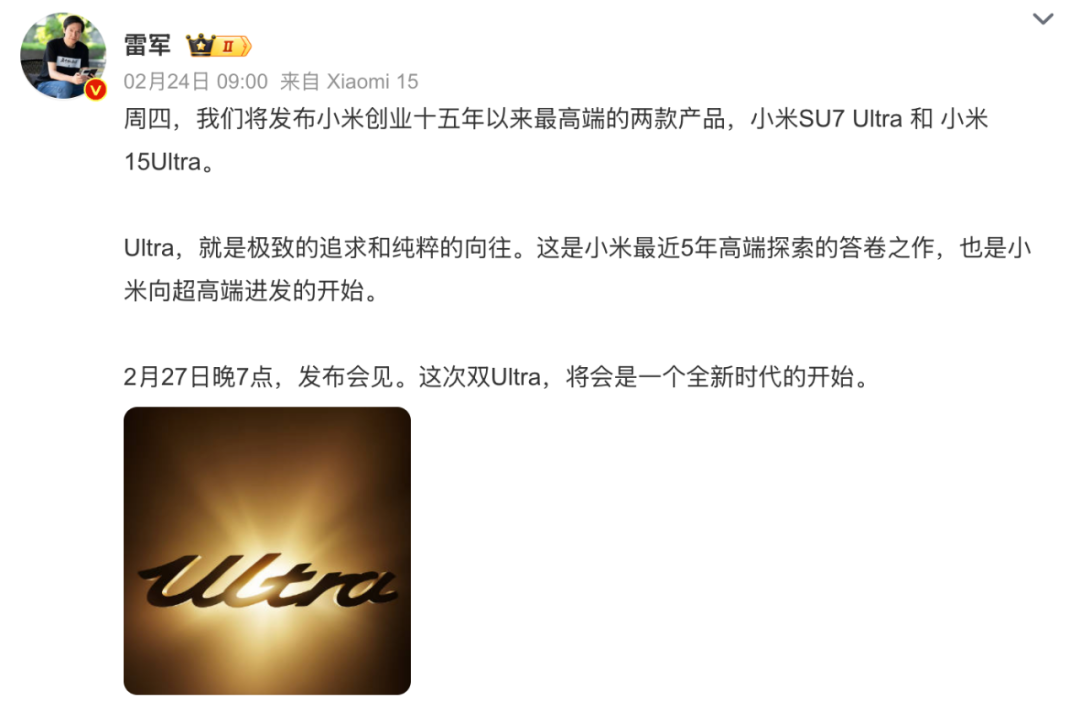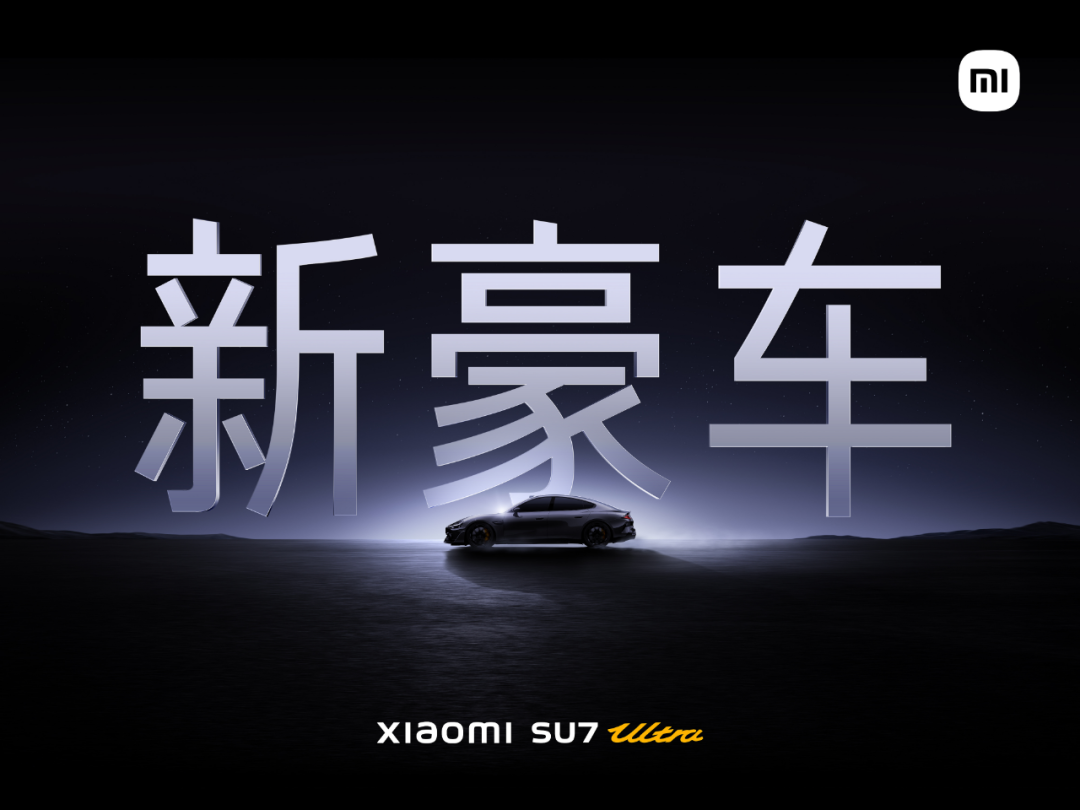SU7 Ultra: Can It Propel Xiaomi Automobile into the "Super High-End" Market?
![]() 03/04 2025
03/04 2025
![]() 554
554
Xiaomi Automobile must avoid the brand dilemma that once plagued Xiaomi smartphones.
text
The highly anticipated SU7 Ultra has finally been unveiled.

After months of persuasion from Lei Jun, Xiaomi's CEO, the final price was set at a more accessible 529,900 yuan, a significant drop from the initial pre-sale price of over 800,000 yuan.
Sales have been impressive, with over 6,900 units ordered in just 10 minutes and 10,000 units in 2 hours.
Lei Jun himself even admitted to suffering from insomnia over the launch.
However, as Xiaomi's most expensive product to date, can the SU7 Ultra truly position Xiaomi as a player in the "super high-end" market?
The answer, unfortunately, is still uncertain.
By stacking top-tier specifications, Xiaomi has managed to price the SU7 Ultra above the 500,000 yuan mark.
Let's be clear: supercars do not resonate strongly with ordinary consumers. The SU7 Ultra is not aimed at the mass market but rather at establishing Xiaomi's presence in the high-end brand segment.
It's a battle for brand perception.
How so? Those familiar with Xiaomi's past strategies will notice a familiar pattern in the SU7 Ultra.
Specifications are pushed to the limit, followed by a competitive pricing strategy.
Consider the SU7 Ultra: with over 1,500 horsepower, a figure previously reserved for multi-million-yuan luxury cars.
In terms of performance benchmarks, the prototype of the SU7 Ultra has become one of the fastest electric cars on the Nürburgring Nordschleife circuit.
Note that it's a prototype, but Xiaomi's marketing has downplayed this distinction.
For most consumers, the SU7 Ultra appears to be the fastest mass-produced electric car in the world.
Visual data and benchmarks are crucial in justifying the SU7 Ultra's price point.
Xiaomi's marketing prowess is also on full display. Beyond the impressive specifications, the company has created a buzz around the product.
Lei Jun boasts that the SU7 Ultra "technologically rivals Tesla, performs comparably to Porsche, and rivals Mercedes-Benz, BMW, and Audi in luxury, enhancing Xiaomi's brand image."
This messaging subtly positions the SU7 Ultra as a luxury car worth millions.
The final price of 529,900 yuan, combined with its perceived high value, is bound to stir up the market.
A car with specifications akin to a million-yuan vehicle but priced at half a million? Consumers attracted by such a value proposition are still driven by cost-effectiveness.
But the crux of the matter lies in brand premium. Few people buy a Porsche or a Maybach because of cost-effectiveness, right?
If the SU7 Ultra succeeds solely on cost-effectiveness, it will attract price-sensitive consumers rather than true high-net-worth individuals.
Even at a price of 500,000 yuan, Xiaomi's brand still struggles to define what "high-end" truly means.
This is a long-standing issue for Xiaomi.
This specification-driven approach mirrors Xiaomi's early days in the smartphone market.
Offering the same specifications at a lower price was the hallmark of Xiaomi's cost-effective strategy.
This resonated deeply with ordinary consumers, who felt they were getting a great deal. Those who didn't buy Xiaomi phones were seen as missing out.
However, this posed a risk to Xiaomi's brand image.
In the smartphone era, Xiaomi fans were known for their "smart" choices. How could a phone costing over 3,000 yuan use a MediaTek processor? Such extreme comparisons and a sense of intellectual superiority once sparked controversy around Xiaomi.
Online, Xiaomi fans often argued that not buying Xiaomi products was akin to paying an "intelligence tax" due to their cost-effectiveness.
Interestingly, as Xiaomi ventured into the automotive industry in the past two years, those early Xiaomi fans have reached the age where they might be considering a car upgrade.
It's somewhat ironic, or perhaps just a coincidence, that a similar backlash has emerged.
After the SU7's launch, live streams from various automakers were "invaded" by Xiaomi fans, who belittled other brands based on specifications. Live stream hosts were forced to deflect, saying things like, "I don't sell the SU7," "I'm just a salesperson, please don't attack me," and "Please don't mention Xiaomi."
The familiar pattern has reemerged.
However, Lei Jun's handling of this situation has matured. He has positioned the SU7 Ultra as a "new luxury car."

This is akin to new money paying homage to old money. While vigorous, it also seeks to establish a sense of heritage.
However, with Xiaomi still grappling with the cost-effectiveness label, whether it can truly redefine luxury in the automotive industry remains to be seen by the market.
Consumers' perception of high-end is intrinsically linked to brand power.
In recent years, Xiaomi smartphones have claimed to have ascended to the high-end market.
Sales in the 4,000 yuan price segment have been encouraging.
However, Xiaomi's large foldable phone, priced at 9,000 yuan, is nearly the cheapest among its competitors.
Why is this the case?
It boils down to a fundamental issue: consumers equate high-end with brand power.
Xiaomi's brand power is synonymous with affordability, attracting consumers who prioritize cost-effectiveness.
This perception inevitably leads to the belief that Xiaomi car buyers belong to the same cost-conscious demographic.
Price-sensitive consumers are not high-end buyers. Instead, they tightly bind the brand's consumer image to the brand itself.
This further excludes true ultra-high-end consumers from considering Xiaomi.
Therefore, as long as Xiaomi continues to rely heavily on visual specification comparisons, it may never transcend into a high-end brand but remain a low-cost alternative to ultra-high-end options.
In this sense, even though the SU7 Ultra is priced above 500,000 yuan, it is still perceived as an "economical car."
At its core, it lacks the luxurious ease and the composure that comes with not seeking external validation.
Xiaomi Automobile must avoid the brand dilemma that once plagued Xiaomi smartphones.
This is our most intuitive takeaway after witnessing the launch of the SU7 Ultra.







